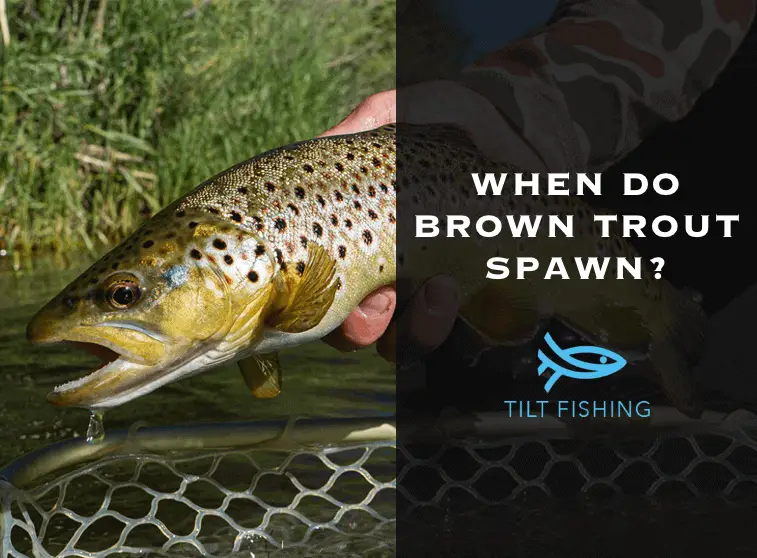Understanding when brown trout spawn and their seasonal behavior is something that ever angler should study and understand. It’s important to recognize this event to ensure spawning areas are protected and the next generation of fish is secured.
So when do brown trout spawn? Brown trout spawn in the fall (usually from September to December) when the water temperature ranges around 44°F to 48°F degrees. The spawning period typically last 2-4 weeks.
The spawn is a fundamental aspect of the ecosystem that allows and secures a future population of fish. As anglers it’s extremely important that we understand when, where and how the spawn takes place for the species we target and interact with.
In this article we are focusing on when brown trout spawn and the things that are important for you to know in relation to this seasonal event.
Understanding the Brown Trout Spawn
As I mentioned earlier in this post, brown trout will begin spawning in the fall. In most places this will usually happened from September to December depending on where you live.
Perhaps one of the best indications on when the brown spawn will occur is the water temperature. The optimal brown trout spawning temperature is 46°F. Once the water reaches 44°F to 48°F in the fall is when brown trout will begin spawning which may last all the way up to December.
In the begging stages female brown trout will dig out areas called redds typically in the gravel substrate of stream riffles. Once these have been created male and female fish will then pass over a redd to lay and fertilize the eggs.
Here is a video that explains more about the spawn process.
How Do You Tell if Trout Are Spawning?
Being able to recognize when the trout spawn is happening and where the spawning zones occurs is extremely important. Being able pick up on certain clues will help allow you to identify what stage the fish are in help you avoid and protect spawning areas.
Here are some key indicators that will tell you if a trout is spawning:
Redds
If you can visibly see redds (nests made by trout) then you know that trout are at least somewhere along the spawning process.
Redds can typically be found where there is shallower water with slower current that has a gravelly bottom. Common places for redds can be found on side channels and on the insides of river turns.
Redds typically look like clean oval patches of small sized gravel that are usually around 2 feet wide. If you see an area like that it’s a great sign the trout are spawning. If you notice a nearby trout that is holding to a site and refuses to move then the trout are in full spawn mode.
Here are some more tips on how to identify a redd.
Darker Colors
When most trout spawn they tend to be darker-colored more than normal. Their bellies will be a lot darker instead of a normal light, silver color. This coloration can be a great way to tell if trout have started to spawn.
Concentrated Shallow Fish
When trout spawn they will concentrate and head for protected shallow water that have a gravel bottom with a slow current. If you notice there are a lot of fish in these areas then odds are the trout spawn is underway.
A Sluggish Fight
Another indication that the trout spawn might be under way is that the trout that you do catch will fight sluggishly. During the spawn they’re expending most of their energy performing their spawning activities. You’ll be able to tell and feel the difference.
Do Brown Trout Feed During Spawning?
In preparation for the spawn brown trout will aggressively feed. However, their feeding significantly decreases during the spawning period which typically lasts 2 to 4 weeks.
During the spawn brown trout are more likely to strike something out of aggression and protection of their spawning area rather than actively feed. Once the spawn is over they will start to increase their feeding as they recover from this event.
Key Brown Trout Spawning Takeaways
- Brown trout spawn in the fall (September to December) when water temperatures are 44°F to 48°F.
- Redds are gravel nest created by trout where they will lay their eggs.
- Redds are located in riffles and gravel bars, typically 1 to 3 feet deep.
- It’s important to protect spawning areas and avoid fishing, walking, wading near redds.
Trout Fishing Resources
- Catch More Brown Trout with These 7 Lures
- 20 Trout Fishing Tips to Catch More Fish
- Best Colors for Trout Lures
- The 7 Best Ways to Catch Trout
Final Thoughts
The brown trout spawn is a fundamental piece of the ecosystem that ensures the next generation of fish. It’s extremely important the we recognize, understand, when and where brown trout spawn and that we be respectful and mindful so that we ensure this wonderful species is around for years to come.

